The Exquisite Joy of Puff Pastry
Ahhh puff pastry! Few things are tastier than a well made puff pastry. That sweet butter taste combined with an exquisite flakiness. Being able the make even a moderately good puff pastry will then open the door to culinary possibilities.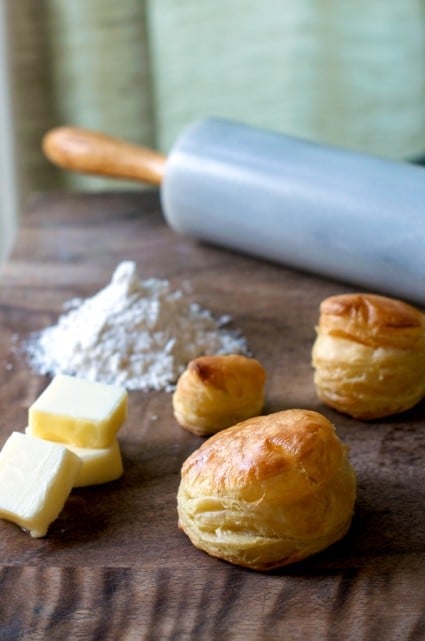
Puff Pastry Recipe
NUMBER ONE key to a good puff pastry is the butter. Go all out here and find the best unsalted butter you can get your hands on, no cost spared. If you are lucky enough to have a store that carries the Plugra brand European Style butter, it is damn tasty and usually sells at a very reasonable price for the 1 lb. brick. Smart & Final carries it in our area (Trader Joes used to 🙁 ) at an exceptional under $3 price.
How to Make Puff Pastry
The start to finish time is a bit long, 3 + hours, but most of that time is chill time in between folds. As long as you aren’t leaving the house for a while, you can get plenty of other dishes made, or chores done, or football games watched while making the magic dragon pastry. Pay attention to the details while making this. A little mistake will magnify later.
Also, when using puff pastry in recipes, keep in mind that their dough may be meant to rise differently than this one. This recipe should rise about 4 times it’s rolled out thickness, but even that will change with how old the dough is or how well it is made.
The dough and formed-ready-to-bake pastries keep very well in the freezer, but not so much in the fridge. This recipe is based off of “The Professional Pastry Chef” by Bo Friberg, we’ve just tweaked a couple of the techniques to what we’ve found to be easier for us.
P.S. If you are going to venture into pastry making, I seriously suggest you start baking by weight if you aren’t already. Get a kitchen scale, especially one that weighs in grams. Pastries are as much science as art and you need to be as accurate as possible. So start weighing out ingredients and have less recipe missteps. After you get used to baking this way, you will love it.
-Todd
Step by Step Recipe Gallery
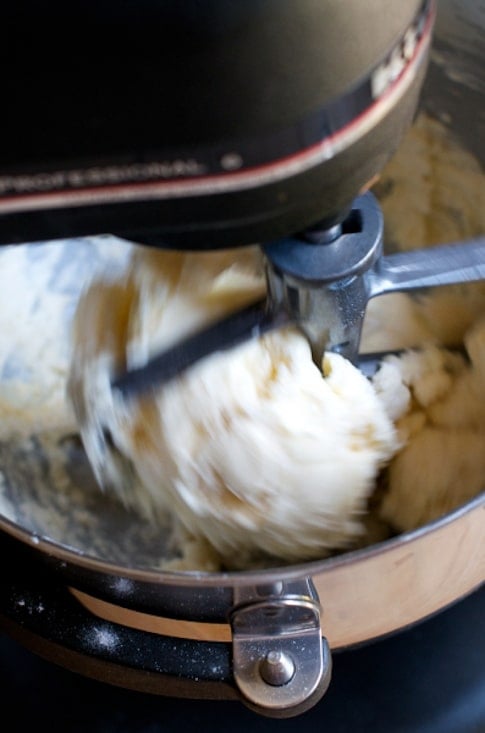
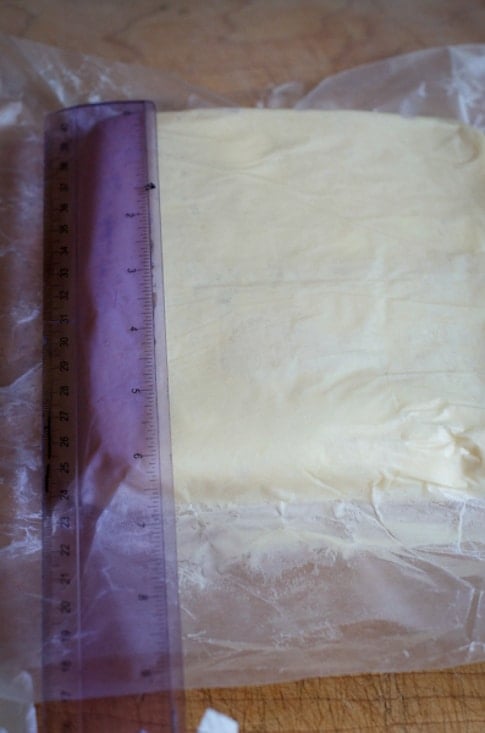
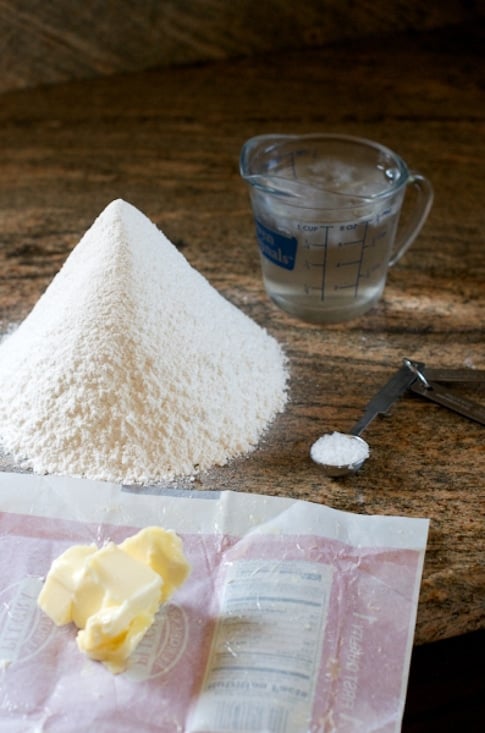
form into a ball
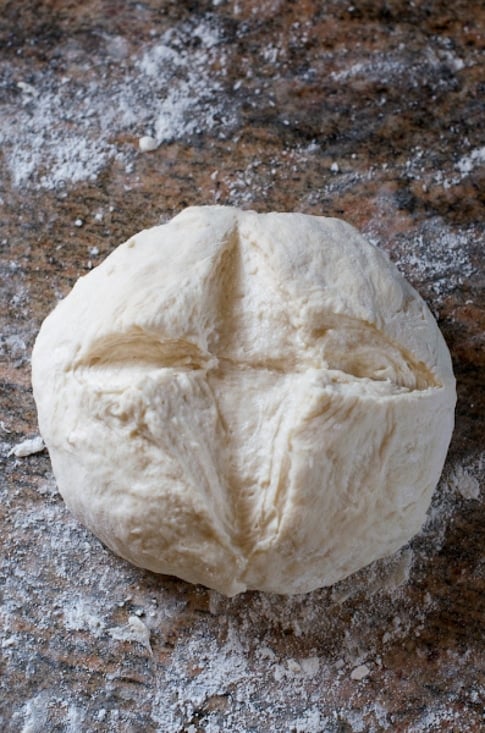
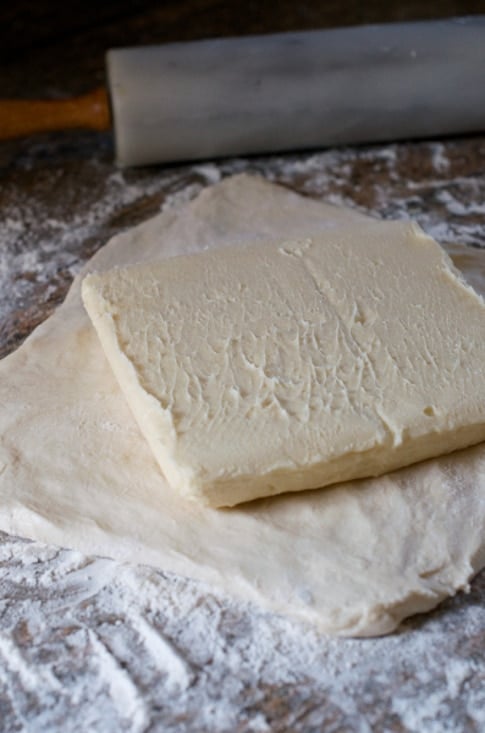
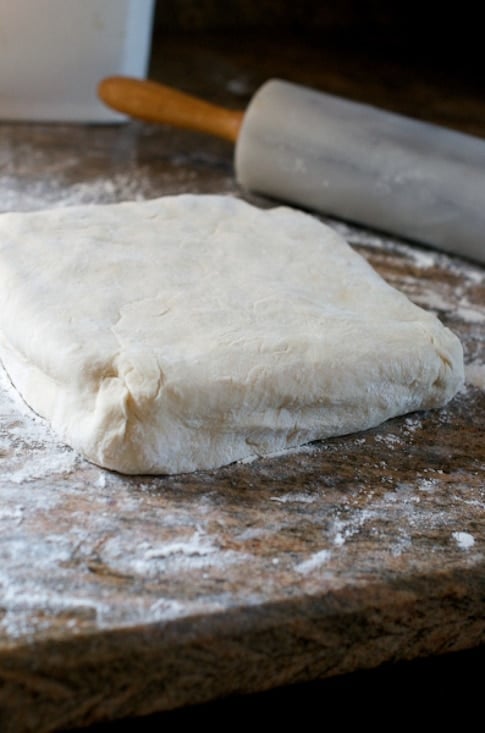
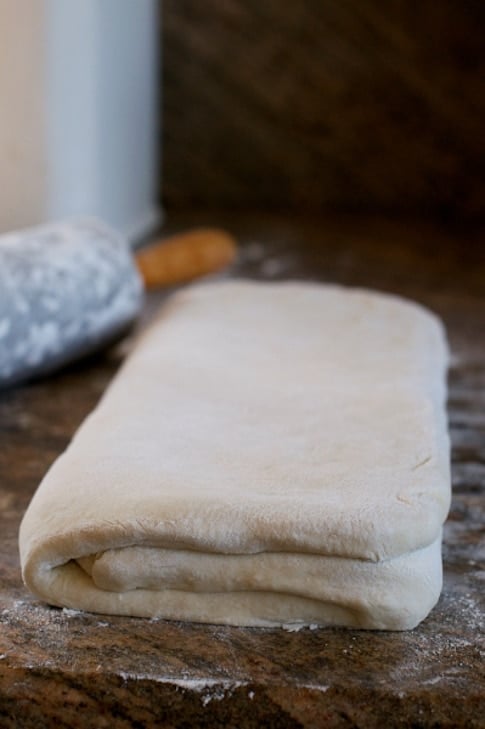
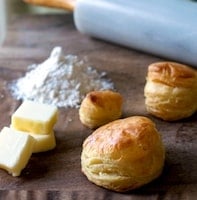
Puff Pastry Recipe
Ingredients
Butter Block Ingredients
- 2 1/4 cups (510g) cold unsalted Butter
- 2 teaspoons (10ml) Lemon Juice
- pinch Salt
- 1 cup (130g) Bread Flour
Dough Ingredients
- 3 cups (410g) Bread Flour, approximately
- 1/4 cup (556g) soft unsalted Butter
- 2 teaspoons Salt
- 1 cup (240ml) cold Water
Instructions
- Make Butter Block: In mixer w/ paddle attachment, work butter lemon juice, salt, and flour into a smooth paste.
- On a sheet of wax paper, roughly form an approx. 6" square with the butter block mixture. Lay another piece of wax paper on top and smooth out the square & straighten the sides. Peel back each wax paper sheet & re-lay as it wrinkles to keep a smooth, even surface. After block's thickness & sides are even, refrigerate until firm.
- Make the dough: Sift flour onto your work surface (preferably something chilly like granite or marble slab) Pinch butter into chunks and place on top of flour. Continue pinching butter into flour until it resembles coarse crumbs.
- Shape into a mound, then make a well in the center of the mound. Add the salt & cold water into the well, then with a fork, use a whisking motion to gradually incorporate the well's sides into the water. When it starts to form a solid mass, finish incorporating the flour by kneading. Incorporate just until it is still sticky and has a rough texture. Adjust the water & flour as needed. Try to knead as little as possible. Puff pastry likes lazy kneaders.
- Form dough into a ball, remember-knead as little as possible. Flatten the ball a bit, then cut a cross halfway through the dough. Wrap it up & let rest in fridge for 30 minutes.
- You'll want the Butter Block to have approximately the same consistency as the Dough, after the dough is rested. You don't want the butter rock hard, but not mushy soft, either. A dough that is softer than the butter will stretch while the butter doesn't. If the butter is softer than the dough, it will be pushed out the sides. Either create difficulties to some degree. You may have to adjust chill/resting times for either dough or butter block so they are about the same. Kitchen temp., how long it took to make the dough, fridge temp., all affect the consistency of the Butter Block & Dough. Figure out adjustments to make so they'll work together homogeneously. It may take a time or two, but you'll get the hang of it. While everything is chilling, get to work. Clean that kitchen up. Then relax & get ready to assemble.
- Assembly: Pull the corners of the cuts out of the dough ball to make a square shape. Roll the dough out to a square slightly thicker in the center than on the sides, and slightly larger than the butter block.
- Place the butter block diagonally on the dough square, so that the butter corners are pointed at the middle of the dough sides. Fold the uncovered dough corners over the butter block to completely envelop the butter. Pinch the seams tightly together to seal in the butter.
- Dust your work surface with flour, and roll the dough into a rectangle about 1/2" thick. Remember to keep dusting with flour whenever needed to keep the dough from sticking & tearing the layers.
- Size up your rectangle visually into 3. Fold one third over the middle, then fold the opposite third over. Just like a tri-fold brochure. Try to have everything as even as possible. All the edges should match fairly closely. Put on a plate, cover, and refrigerate for about 30 minutes. Relax, read the paper, check email, whatever you like.
- Roll out to 1/2" thick and repeat the fold. Don't forget to flour as you roll. Plate, cover, and refrigerate for 30 minutes. Repeat this for a total five roll & folds.
- After the last fold, roll the rectangle out to about 3/4". If it is difficult, put dough in the fridge for a bit to relax the gluten. If using immediately, cover, rest in fridge for about 30 minutes, then use as needed. If it's for later, cut into sections big enough but that still fit easily in your freezer (usually just in half), layer with wax paper between sections, freezer bag it, & store until needed.

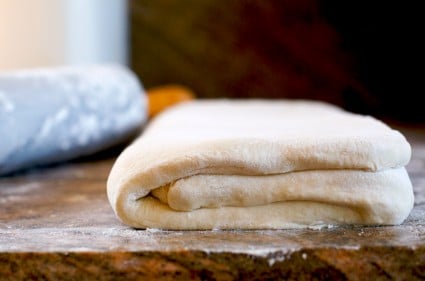
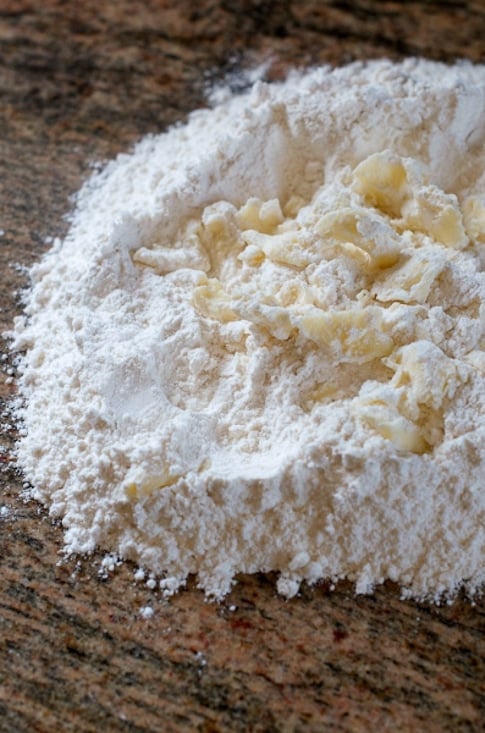
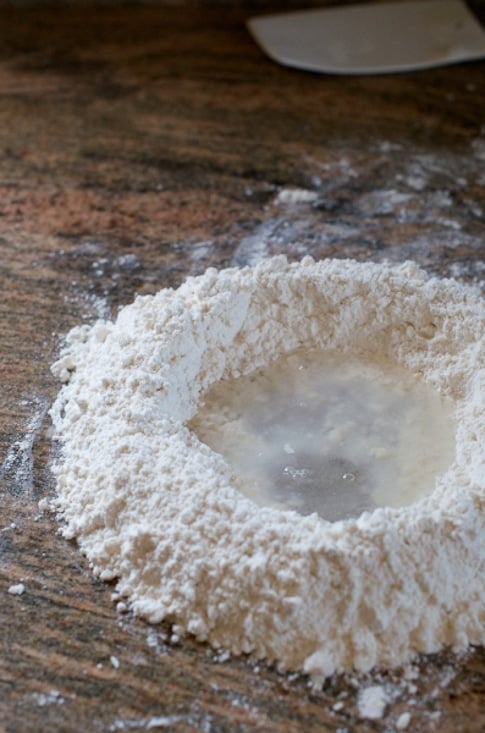
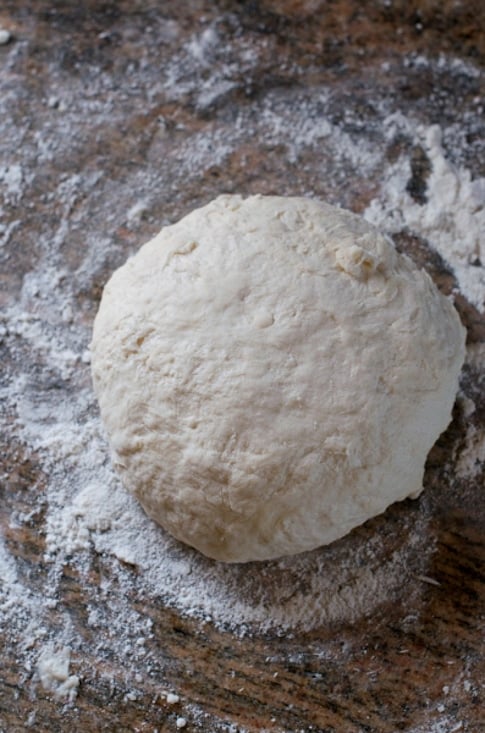
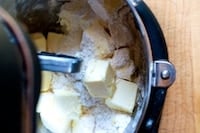

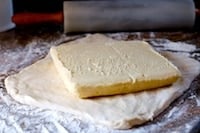




could you use semolina flour for the pastries? I just got it for the first time and wasnt sure if it would work. i know that kind of flour is for pastries and wanted to make this. i also have all purpose flour if that works better. thanks!!! 😉
We’ve never tried making puff pastry with semolina flour. We’ll use all-purpose frequently and the texture is great. If you end up trying it with semolina flour we’d love to hear how it turns out.
hello
for the butteer can i use normal unsalted butter or i have to use special butter for that
Normal unsalted butter works just fine. If you find a butter you like the flavor of best, we find you can distinguish the difference and makes it worth the splurge. However, it homemade puff pastry is still great with just about any butter you can buy. Have fun!
hey, thank you so much for great lesson. that was my first puff pastry made from scrach and it did not raise up as much as yours, but after about 5 hours being ingaged i finally have my first ever cake napoleon. and i am feeling great :}}}}}}
OH MY GAWSH. So flaky, so buttery.
Not too hard to make, looks and tastes SO professional! Even in my electric oven it came out fabulous with a light egg wash and cinnamon sugar.
I was very patient and careful and followed ALL of the directions, including the tip about the Pelugra butter (that stuff is so good, the first time I bought it, I just ate chunks of it on crackers like cheese). Anyway, the pastry came out so well! I made blueberry turnovers with it and my boyfriend is currently “mmmmmm”-ing and “ooooo”-ing uncontrollably. I highly recommend this recipe if you are looking to put on a few pounds (haha), or are hoping for your significant other to propose significantly sooner than anticipated (hahaha), or if you need a secret weapon in securing your rightful place as Queen (or King) of the kitchen!
Thank you for demystifying a rather magical part of food life!!
Awesome! This is one of the few blog recipes we are including in upcoming cookbook and we’re happy to hear people have success with it. That’s all we hope for!
Todd
I have been looking for a good authentic puff pastry recipe for some time. Thank you for an easy to follow version and for clear photographs. Your comments regarding the quality butter are spot on. I grew up in Europe and can recall just how important butter in baking is. I look forward to turning out some puff pastry as well as your own.
How much does this make? I only need 1/2 lb. Also, is there a difference between all-purpose flour and bread flour?
This recipe makes about 2 pounds. Rather than reduce the recipe, we would suggest to freeze the extract puff pastry. We will usually make a double batch and freeze the extra. You can use either bread flour or all-purpose equally well in this recipe.
Hope that helps. Have fun!
T
Thank you soooo very much for posting this recipe! I’ve made it twice now and absolutely loved the results. By far the most amazing pastries I’ve ever had. It’s so wonderful that I posted a recipe on my blog using this dough and linked you. 🙂
SUCCESS!!!!! Thank you so much for this recipe. It was my very first time making puff pastry and I was very excited to see it bubbling and puffing up in the oven. It is a LITTLE too buttery, if there is such a thing, but I’m sure that is just preference.
I have tried many puff pastries at home… but can’t make it up to the perfection… you have described the recipe in a very simple way with good pictures, now i’m sure i will make the pastries up to the standard.. really a nice post…
Thanks so much David. Good luck on your next batch! Another tip I’ve picked up after watching some professional pastry chefs making the dough, is to not make the rolling pin do all the work in rolling out. They will continually pat the edges or make little adjustments by hand to keep everything squared up and straight while rolling out.
Love to hear how it comes out for you.
T